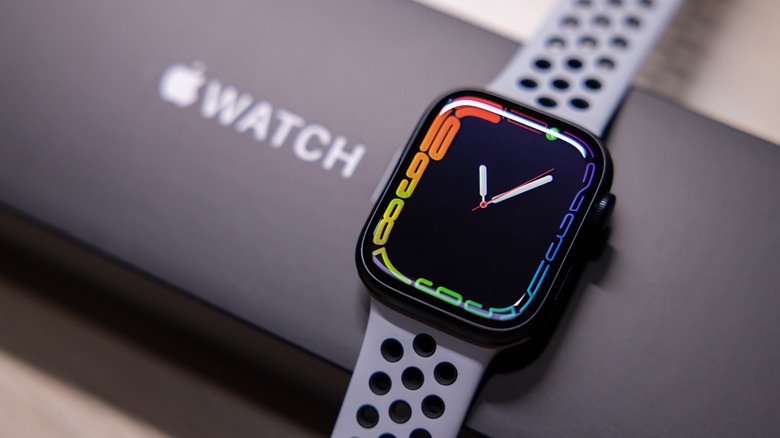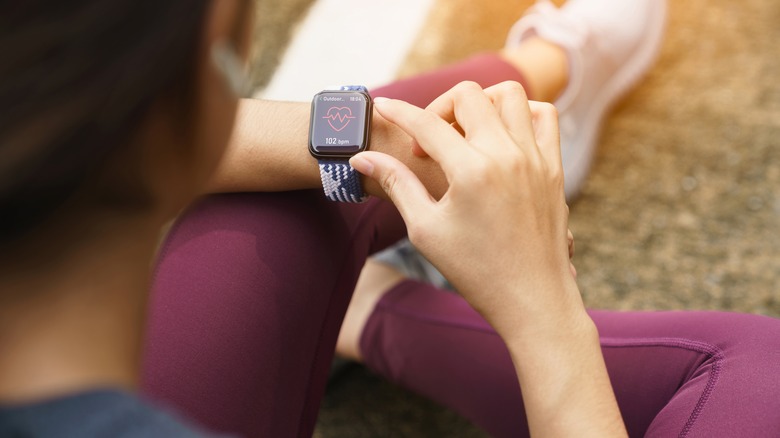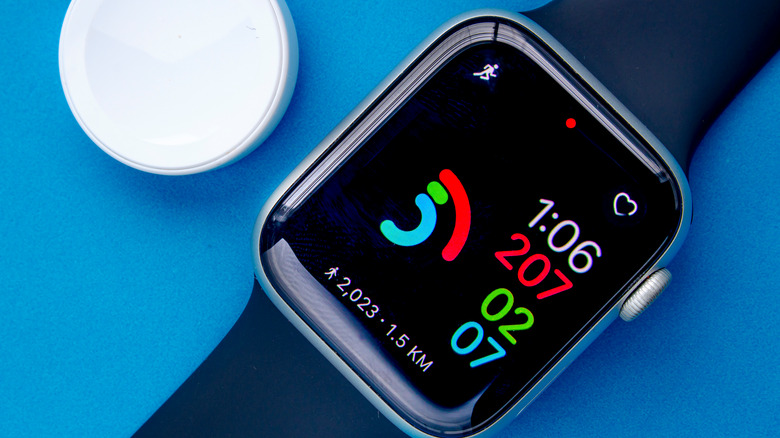The Apple Watch Still Doesn't Have Dark Mode, But Here's How To Set Up The Next Best Thing
Apple Watch has revolutionized the lives of users around the world. Just as smartphones evolved from devices that make calls to devices that do absolutely everything (there is, almost invariably, an app for that), simply telling the time is the most rudimentary of features Apple Watch offers. From Taptic Time to location sharing and monitoring your health, Apple Watch is chock-full of functions. It doesn't, however, have a setting that popular websites and older laptops all seem to have incorporated some time ago: Dark mode.
Instead of a proper dark mode, it's possible to emulate the effect using Apple's Shortcuts app to switch between Apple Watch faces. Here's a quick step-by-step guide to doing it. You'll need an iPhone with the Shortcuts app installed and your choice of light- and dark-appropriate faces for your Apple Watch.
Your first port of call, if you don't already have both a light and dark face for your Apple Watch, is to add them. Doing so is as simple as holding your finger on the Apple Watch face and navigating to the right. Using the Digital Crown, you can scroll through the options and add your favorite low-light and bright-light watch face to your rotation of faces using the Digital Crown (one of each is needed). Note the name of the two watch faces you've chosen, as you'll need them later, 9to5 Mac explains.
What is Apple Watch's dark mode workaround?
The goal is to set your Apple Watch to emulate dark mode by switching from one to the other at appropriate times of the day. For this, the Shortcuts app will be needed.
-
If you don't already have the Shortcuts app installed, download it from the App Store.
Advertisement -
From the Automation tab on the Shortcuts home screen on your iPhone, select Create Personal Automation.
-
Select the very first option, Time Of Day.
-
Input the time you'd like your Apple Watch to activate your "dark mode" face. For instance, if you use your Watch late in the evening, maybe set it to start at 9 p.m.
-
In the Repeat box, select Daily.
-
In the Actions box, select Add Action.
-
Select the Watch app from the list, then Set Watch Face.
-
Select the name of the "dark mode" watch face you chose in "set active watch face to ..."
-
Confirm your choice, and your Apple Watch will automatically transition to night mode every night at the selected time.
As Byte Review on YouTube notes, the Ask Before Running slider should be deactivated using the toggle, or it'll ruin the seamless transition from daytime to nighttime mode.
It's then a simple case of repeating steps one through nine for your light, "daytime" Watch face. With step four, in this case, setting a time that coincides with your morning alarm (if you have one) would be a great choice.
Why set a dark mode workaround for your Apple Watch?
Dark mode is a standard option on various devices and platforms. For many users, it's just an aesthetic preference. Perhaps you might spend most of your working day typing into a sheer white Word Document and crave something a little easier on the eyes.
For some people, blue light is a big concern. In January 2010 study "What's in a Color? The Unique Human Health Effects of Blue Light," by David C. Holzman (via PubMed), it is suggested that "a reduction of the blue portion in artificial light during nighttime hours could protect shift workers against disorders such as cancer and cardiovascular disorders as well as reduce sleep disturbances and their consequences among the general population." One primary effect of ubiquitous dark modes is to reduce this glow (hence their frequent use as night modes), which could have health benefits beyond simply aiding in the practical visibility of the screen.
Such modes have their detractors, and it can be argued that darker screens are less natural than the lighter, paper-esque screens we're more familiar with. More research is needed on the matter, but for Apple Watch users, it can simply come down to having the option if desired. Until a proper dark mode is implemented, if it is, this is the next best thing. iPhone users have found that dark mode can help battery life, among other things.


